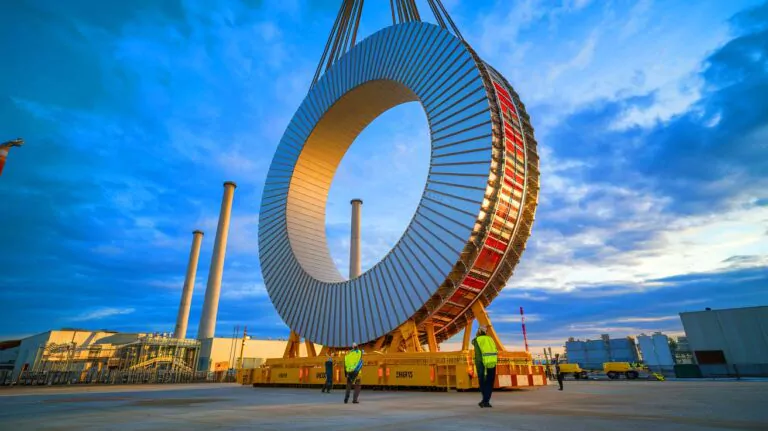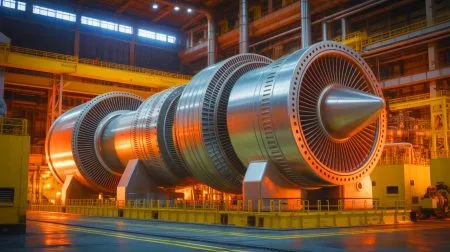| IN A NUTSHELL |
|
The ambitious journey of nuclear fusion is taking a significant leap forward with the completion of a pivotal component for the ITER project. The United States has delivered a colossal superconducting magnet, an essential part of the world’s largest fusion experiment located in France. This remarkable structure, standing at 59 feet tall, plays a crucial role in the ongoing efforts to harness the power of fusion energy. As the world watches, the assembly of this technological marvel brings us closer to realizing the dream of unlimited, clean energy.
The Role of the Central Solenoid
The central solenoid is the heart of the ITER fusion reactor, designed to initiate and sustain the plasma necessary for nuclear fusion. Comprising six individual magnetic modules, each weighing approximately 267,000 pounds, this superconducting magnet is pivotal in maintaining the delicate balance required for fusion reactions. The central solenoid’s primary function is to confine and stabilize the plasma, enabling the high temperatures and pressures needed for fusion.
Ensuring the stability of such a massive structure requires a robust support system. The solenoid’s exoskeleton, sometimes referred to as a cage, is engineered to withstand the extreme forces generated during the fusion process. As David Vandergriff, a lead engineer at Oak Ridge National Laboratory, highlights, the solenoid’s efficiency is contingent on its support structure. The successful integration of this component marks a significant milestone in the ITER project, solidifying its place as a groundbreaking endeavor in nuclear science.
The Collaborative Effort Behind the Engineering
The construction of the solenoid’s support structure involved a collaborative effort among eight American companies, showcasing the collective expertise required to tackle such a monumental task. One of the standout contributions came from Superbolt in Pennsylvania, which developed the critical technology to secure the assembly under extreme conditions. The intricate design features 27 vertical connectors, or tie plates, forming the backbone of the cage. These components link the lower foundation blocks to the upper blocks, creating a rigid enclosure around the solenoid.
Freudenberg, an engineer involved in the project, elaborates on the challenges faced during the design phase. Producing the 49-foot-long tie bars as single pieces, with stringent tolerances, was a major engineering hurdle. Collaborating with specialized forges, the team overcame these obstacles, ensuring the structural integrity of the support system. This achievement underscores the complexity and innovation inherent in the ITER project, highlighting the collaborative spirit driving its progress.
Progress and Milestones in ITER’s Assembly
As ITER progresses, the assembly of the central solenoid is nearing completion. Four out of the six modules have already been installed at the site in southern France, with the final two modules expected to be mounted by the year’s end. This phase represents the culmination of a decade-long effort by the American team, bringing to fruition a project of titanic proportions.
The successful installation of the solenoid modules is a testament to the meticulous planning and execution involved in ITER’s construction. Despite the challenges and delays that have characterized the project, its importance as a flagship for fusion energy remains undiminished. As the world looks on, ITER stands as a beacon of hope in the quest for sustainable, clean energy, setting the stage for future advancements in nuclear fusion technology.
Understanding ITER’s Global Impact
ITER, the world’s largest experimental nuclear fusion reactor, is a testament to global collaboration, involving 35 countries, including the United States, China, India, and the European Union. The project’s objective is to demonstrate the feasibility of fusion energy by 2040, aiming to produce 500 MW of power from just 50 MW of input. Originally estimated at $5 billion, the project’s cost has surged to nearly $24 billion, with funding predominantly from the EU and contributions from other member countries.
Located in Saint-Paul-lez-Durance, France, ITER represents a monumental effort in scientific and engineering innovation. Despite financial and logistical challenges, it continues to be a cornerstone of fusion energy research. As ITER progresses, it not only advances our understanding of nuclear fusion but also fosters international cooperation in the pursuit of a sustainable energy future.
The journey toward harnessing fusion energy is fraught with challenges, yet the progress made with ITER brings us closer to a transformative energy source. As the components of this massive project come together, one must wonder: What new breakthroughs will emerge from this daring endeavor, and how will they reshape our global energy landscape?
Did you like it? 4.6/5 (28)








Is it true that the cost of the ITER project has surged from $5 billion to almost $24 billion? 🤔
What happens if/when Russia bombs the ITER site?
Yes
All research does out strip initial budgets
Would never start otherwise
So, the U.S. is basically the superhero of this fusion story? 💪
Ha ha, no they are not, this article makes it sound like us contribution to this projects is the bigest and they are heros…
Obvious Answer… “NO”.
Where’s the US’s Fusion Reactor ? ? ?
ITER sounds promising, but I’m worried about the environmental impact of nuclear fusion. Are there any risks?
Wow, a 60-foot magnet! That’s some serious engineering marvel! 👏
With so many countries involved, I hope this doesn’t turn into a political mess. 😬
Thank you for the detailed explanation about the solenoid’s role. It’s fascinating!
Is anyone else confused about how a magnet can help with nuclear fusion? 🤷♂️
What happens if the solenoid doesn’t work as planned? Is there a backup plan?
I’m impressed by the collaboration among American companies. Teamwork makes the dream work! 🚀
Why does it feel like ITER is always “almost” completed but never really finished?
Are there any other countries besides France and the U.S. actively contributing to the ITER project?
How does the plasma confinement work? Sounds like sci-fi stuff! 🔬
It’s amazing to see countries working together for a common goal. More of this, please! 🙌
Anyone know how they transport a 60-foot magnet all the way to France without causing chaos?
The scale of this project is mind-blowing! How long before we see fusion energy in our homes?
I’m skeptical. What if this turns out to be another expensive experiment with no real results?
Great to hear about progress in clean energy, but will fusion ever be cost-effective?
Thanks for the article! I learned a lot about nuclear fusion today. 😊
Sounds like a massive project. What’s the estimated completion date for ITER?
Why do they need six solenoid modules? Is one not enough?
Probably to “encase” or “surround” or “envelope” the reactor to ensure “containment.
I’m neither an engineer nor a scientist in these fields, I’m more IT and tech support, but I’m interested in the advancement of those fields. Go on quora and ask the question, or an AI “agent” like chatgpt or poe, you may get an answer there.
ITER’s budget is almost $24 billion now? That’s a lot of money! 💸
What are the main challenges the ITER team is facing right now?
How do they ensure the safety of such a large and powerful magnet?
I’m excited for the future of clean energy. Go ITER! 🌞
How does the U.S. benefit from helping with the ITER project?
Can’t wait to see if this project actually succeeds. Fusion energy could change the world! 🌍
Just a random question, but don’t you think that this, basically oversized magnet can alter our gravitational field and maybe destroy it causing us a complete catastrophe?
How long did it take to build this superconducting magnet?
Why is the U.S. helping France with this project when they have their own energy issues?
I told them we already got one
I told them we already got one.
Wow
Ms Dinoo should know that ITER is jointvproject involving overc30 countries. TArticle headline is insulting to other people involved. If FRANCE can’t do it alone neither the USA can do it alone.
CERN and ITER are proof that humanity has to work together rather than FIGHT
If this project is being run by the same folks who are running California’s high speed rail train then this sucker is gonna cost over $500 billion by year’s end.
Thanks, libs, we don’t know where we’d be without your corruption and your ineptitude…
Awesome. It’s good to see we’re finally seeing progress being made in fusion science.
What kind of amateuristic journalism is this? Who came up with the stupid headline? The whole point of this ITER (International Thermonuclear Experimental Reactor) project is that it is an INTERNATONAL project. France never tried to do it alone or claimed it as theirs.
“60-Foot … 267,000 pounds … 49-foot-long”
Please include metric unit measurements in your article.
Hina Dinoo – look what people think of you journalism reddit /r/europe/s/jWhWvLRLj0
There are other top secret uses for this technology. The public is being lied to, and chasing a never-ending fairy tale of free energy.
Articles like this contribute to a distorted view of global events, and the sensational headline does a disservice to ITER, a complex international project involving 35 countries. While the U.S. did deliver an important 60-foot superconducting magnet, it’s just one component of a much larger, decades-long effort. The oversimplification and exaggeration in the headline misrepresent the collaborative nature of this work, which includes contributions from nations like Russia, China, India, and the EU. It’s frustrating to see such a lack of understanding about how these global partnerships function, and the writer should really reconsider their approach.
Imagine turning that bad boy on where it’s not supposed to be turned on. Cool possibilities include:
-A ship at sea
-In the middle of downtown Paris
-Next to the Eiffel tower
-Next to an MRI machine
-next to a foriegn president’s head with a shipping container on the other side
The French could do so many cool things now!
Umm. Is no one concerned about global impact of a magnet this huge . I mean don’t we already have a issue with the earth’s core and the magnetic field around the earth.let alone the pole shifts? I mean wouldn’t they have to put a magnet on the exact opposite side of the earth to prevent any long term “mishaps” I mean that’s a huge magnet. And not just a magnet a suer conductive magnet. Fuck the money money won’t be shit if you throw the planet into chaos. Just think of it this way what happens if you put a piece of metal into a cat scan machine. Guys this could be bad I mean bad bad
It will cost $84B after tariffs.
Can I use this to wipe my hard drive? 🤓
Who wants to hear all this crap about clean free unlimited energy for all. Thats a straight and utter lie. Rates will go up as they usually do. We, the comsumer, will pay for every aspect of this “unlimited” energy. But with all the greed and corruption woven into these projects, it’ll be a circus to funnel shady investment money thru, (laundering) and fleece honest investment with the same promise that got Tesla destroyed.
Looks like a stargate:)